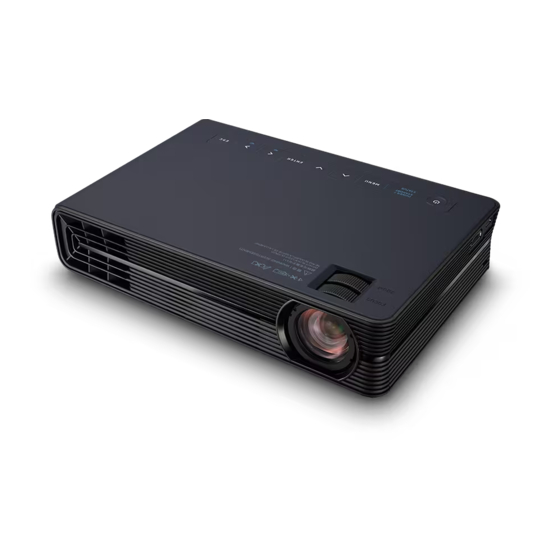
Table of Contents
Advertisement
Quick Links
PROJECTOR
CX-E1
CX-F1*
*Network Model
BATTERY
(Option)
YA-B10
User's Guide
Be sure to read the "Safety Precautions" and "Operating Precautions" and make sure you use this
product correctly.
Keep this manual in a safe place for future reference.
Visit the site below for the latest version of this manual.
https://world.casio.com/manual/projector/
1
EN
Advertisement
Table of Contents
Troubleshooting

Summarization of Contents
Safety Precautions
About Safety Symbols
Explains danger, warning, and caution symbols for safe use.
Battery Safety Precautions
Covers charging, usage, storage, and handling of batteries.
AC Adapter and Power Cord Safety
Precautions for AC adapter, power cord, and connectors.
Product Operation and Environmental Safety
Warnings about liquids, dust, ventilation, and environment.
Physical Hazards and Handling Precautions
Risks from disassembly, dropping, heat, and light exposure.
Storage and Location Guidelines
Guidelines for storing and operating the projector in various locations.
Wireless Adapter and Electronic Interference Safety
Safety related to wireless adapter and electronic interference.
General Cautions and Maintenance Advice
Cautions for data backup, cleaning, and general product care.
Operating Precautions
Light Source and Laser Safety
Warnings about the light source, lens, and laser.
AC Adapter and Battery Operation Guidelines
Precautions for AC adapter cord and battery operation.
General Operating and Environmental Care
Advice on soft case, environment, dust, and signals.
Projector Usage and Cleaning
Avoiding damage, cleaning, and screen dot behavior.
Image Quality and Environmental Factors
Keystone correction, condensation, and battery disposal.
Getting Ready
Unpacking and Initial Setup
Checking contents and initial network model setup.
Projector Hardware Overview
Identifying projector parts, terminals, and indicators.
Powering the Projector
Using AC adapter and battery for power.
Battery Status and Management
Checking battery level and handling low battery warnings.
Basic Projector Operation
Turning projector on/off and auto-power features.
Projector Placement and Setup Adjustments
Positioning the projector and adjusting angles.
Connecting Devices and Controllers
HDMI Cable Connection
Connecting projector via HDMI for image and audio.
Wireless LAN and Audio Output
Connecting via wireless LAN and audio devices.
LOGO Terminal for Updates
Using LOGO terminal for firmware and logo updates.
Remote Controller Operation
Using the wireless remote controller for operations.
Operating the Projector
Input Source Management
Automatic switching between input sources.
Frequent Functions and Setup Menus
Accessing common adjustments and settings.
Image Adjustment Procedures
Adjusting keystone, brightness, color, and aspect ratio.
Advanced Projector Settings
Changing input source, setup menu, and color modes.
Image Manipulation and Test Patterns
Flipping image, using test patterns, and control panel lock.
Timer and Password Functions
Using presentation timer and setting projector passwords.
Troubleshooting
Understanding Operation Indicators
Understanding projector status indicators.
Error Messages and Status Codes
Common error messages and required actions.
Projector Problem Diagnosis
Common problems and recommended solutions.
Specifications and Appendix
Mounting and Installation Guidelines
Instructions and precautions for ceiling mounting.
Projection Distance and Screen Size
Table showing projection distance vs. screen size.
Supported Input Signals
List of compatible input signals.
Projector Technical Specifications
Technical details of the projector models.
Battery and Accessory Specifications
Technical details of the optional battery and soft case.
Compliance and Licensing
FCC Compliance Notices
FCC compliance and safety notices.
Open Source Software Licenses
Information on open source software licenses used.
















Need help?
Do you have a question about the CX-F1 and is the answer not in the manual?
Questions and answers